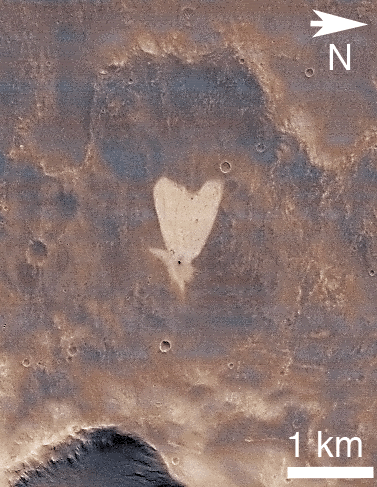
Explanation:
That's no sunset.
And that thin red line just above it -- that's not a
sun pillar.
The red glow on the horizon originates from a
volcanic eruption,
and the red line is the eruption's reflection from fluttering
atmospheric ice crystals.
This unusual volcanic
light pillar was captured over
Iceland earlier this month.
The
featured scene looks north from
Jökulsárlón toward the erupting volcano
Bárðarbunga in the
Holuhraun lava field.
Even the foreground sky is picturesque, with textured grey
clouds in the lower atmosphere, shimmering green
aurora in the upper atmosphere, and bright stars far in the distance.
Although the last eruption from Holuhraun was in 1797, the present
volcanic activity
continues.

Explanation:
Launched on November 18, 2013, the MAVEN
(
Mars
Atmosphere and Volatile EvolutioN)
spacecraft completed its interplanetary voyage
September 21, captured into a wide, elliptical orbit around Mars.
MAVEN's imaging ultraviolet spectrograph has already begun
its planned exploration of the Red Planet's upper atmosphere,
acquiring
this image data from an altitude of 36,500 kilometers.
In false color, the three ultraviolet wavelength bands
show light reflected from atomic hydrogen (in blue), atomic oxygen (in green)
and the planet's surface (in red).
Low mass atomic hydrogen is seen to extend thousands of kilometers
into space, with the cloud of more massive oxygen atoms
held closer by Mars' gravity.
Both are by products of the breakdown of water and
carbon dioxide in Mars' atmosphere and the MAVEN data can
be used to determine the rate of water loss over time.
In fact, MAVEN is
the first mission dedicated
to exploring Mars' tenuous upper atmosphere, ionosphere and
interactions with the Sun and solar wind.
But the most recent addition to the
fleet
of spacecraft from planet Earth now in
martian orbit is MOM.

Explanation:
The large majestic
Lagoon Nebula
is home for many young stars and hot gas.
Spanning 100
light years across while lying only about 5000 light years distant, the
Lagoon Nebula is so big and bright that
it can be
seen without a
telescope toward the
constellation of
Sagittarius.
Many bright stars are visible from
NGC 6530, an
open cluster that
formed in the
nebula only several million years ago.
The greater nebula, also known as
M8 and NGC 6523,
is named "Lagoon" for the band of dust seen to the
left of the open cluster's center.
A bright knot of gas and dust in the
nebula's center is known as the
Hourglass Nebula.
The featured picture is a newly processed panorama of
M8, capturing five times the diameter of the Moon.
Star formation continues in the
Lagoon Nebula as witnessed by the many
globules that exist there.


Explanation:
Galaxies, stars, and a serene reflecting pool combine to create this memorable land and skyscape.
The featured panorama is a 12-image mosaic taken last month from the
Salar de Atacama
salt flat in northern
Chile.
The calm water is
Laguna Cejar, a salty lagoon featuring a large central
sinkhole.
On the image left, the astrophotographer's fiancee is seen capturing the same photogenic scene.
The night sky is lit up with countless stars, the
Large and
Small Magellanic Cloud galaxies on the left,
and the band of our
Milky Way galaxy
running diagonally up the right.
The
Milky Way
may appear to be causing havoc at the horizon, but those are just the
normal lights of a nearby town.

Explanation:
For astrobiologists,
these may be the four most
tantalizing moons in our Solar System.
Shown at the same scale, their exploration by interplanetary
spacecraft has launched the idea that moons, not just
planets, could have environments supporting life.
The Galileo mission to Jupiter discovered
Europa's global subsurface ocean of liquid water
and indications of
Ganymede's
interior seas.
At Saturn, the Cassini probe detected erupting fountains of water ice
from
Enceladus indicating warmer subsurface water on
even that small moon, while finding surface lakes
of frigid but still liquid hydrocarbons beneath the dense atmosphere
of large moon
Titan.
Now looking beyond the Solar System,
new
research suggests that sizable exomoons,
could actually outnumber
exoplanets in stellar
habitable zones.
That would make moons the most common type of habitable world
in the Universe.
Comet CG01 Rosetta in full zoom
Potentially Habitable Moons in full zoom




































































